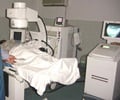Researchers discovered metabolites in urine and created a strip-type urine sensor that can magnify the light signal of those compounds to diagnose cancer.
- Different metabolic components seen in urine can help differentiate cancer patients from cancer-free people
- By irradiating light in a small volume (10uL) of urine, this technology can be used to diagnose prostate cancer and pancreatic cancer without the need for extra analysis
- The diagnostic equipment is made in the form of a strip, allowing cancer to be diagnosed swiftly and accurately
Urine Strip for Diagnosing Prostate Cancer and Pancreatic Cancer
This technique can be used to examine prostate cancer and pancreatic cancer without the need for additional analysis by irradiating light after a tiny volume (10uL) of urine drops at the time of need for a test. The test gadget is made in the shape of a strip so that cancer can be identified fast and accurately in the field.Urine Strip Analyzes Urine Metabolites for Cancer Diagnosis
The researchers focused on the differences in metabolomic components found in the urine of cancer patients and healthy people. Because of faulty metabolism, cancer cells produce several compounds in urine when they grow in the body. To qualify as an established technology, extensive and expensive equipment was required, limiting on-site field applicability. By constructing a coral-shaped plasmonic nanomaterial on porous paper, the researchers created a surface-enhanced Raman scattering sensor that amplifies the optical signal of metabolites in urine more than 1 billion times. When urine is injected into the sensor and exposed to light, cancer metabolite signals are magnified on the sensor surface, allowing cancer to be diagnosed. The research team used an artificial intelligence-based analysis method on the obtained spectral data and was able to differentiate up to 99% of prostate cancer and pancreatic cancer patients from healthy people.Recent Developments in Cancer Detection
Several recent cancer detection approaches use blood tests or radiological procedures to identify cancer and histological analysis to diagnose cancer. Many people try to track the incidence of cancer through annual health examinations, but cancer is often identified late, causing treatment to be delayed or death to ensue. Because it is difficult for those who are in the medical blind spot to have regular exams, cancer is sometimes found after it has advanced significantly.Urine: A Non-Invasive Cancer Detection Approach
Urine, a biological sample that anyone can get, was used in this investigation. It can be utilized for a new cancer detection approach based on urine, on-site quick cancer patient screening, and post-treatment recurrence monitoring technologies. Furthermore, because the strip-type sensor's production cost is less than KRW 100 per unit, it is projected to be employed for mass inspection. Senior researcher Ho Sang Jung, who is in charge of the research, said, “In the case of cancers where the diagnosis method is not well known, such as pancreatic cancer, it is difficult to detect and the survival rate after initial diagnosis is low. It is known that 14 pancreatic cancer patients die every day in Korea, and the economic cost per person is about 63 million won per year.”He continued, “Since early diagnosis is the most important for incurable diseases such as cancer, we expect this technology to provide a new diagnostic method.”The study team is currently expanding the forms of cancer that can be diagnosed by analyzing the urine of individuals with prostate cancer, pancreatic cancer, colorectal cancer, and lung cancer.
Source-Medindia


![Prostate Specific Antigen [PSA] & Prostate Cancer Diagnosis Prostate Specific Antigen [PSA] & Prostate Cancer Diagnosis](https://images.medindia.net/patientinfo/120_100/prostate-specific-antigen.jpg)













